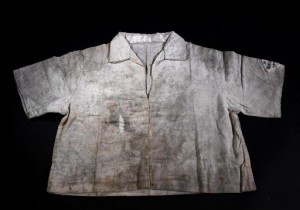Silent Witness: Girl’s shirt remains stained with A-bomb’s black rain
Jun. 25, 2018
by Sakiko Masuda, Staff Writer
In the aftermath of her experience of the atomic bombing, a 16-year-old girl became exposed to the “black rain” that fell during her escape. Dark stains remained on the P.E. class shirt that she was wearing on that day. Even after washing it a number of times on a washboard, she said, the stains persisted. Scientific testing on the shirt, undertaken more than 70 years after the bombing, detected a slight amount of cesium 137, a radioactive substance.
Kiyoshi Shizuma, 69, an emeritus professor at Hiroshima University and an expert in radiation physics, has been studying the radioactive fallout from the bomb, including the radioactivity of the black rain that was triggered by the bombing.
The storage room of the Hiroshima Peace Memorial Museum holds many A-bombed artifacts that show traces of the black rain. In 2016, Professor Shizuma received permission from the museum to measure the radiation found on four pieces of A-bombed clothing at Hiroshima University. In addition to the P.E. class shirt, the presence of radiation was also measured on a sailor-style school uniform, a burnt shirt, and a loincloth, items that were apparently exposed to the black rain at places in present-day Naka Ward and Nishi Ward. A small amount of Cesium 137 was detected on all of them.
The person who once wore that P.E. class shirt is Toyoko Matsumiya (née Kubota), 89, who now lives in Mihara, Hiroshima Prefecture. Back then, Ms. Matsumiya was a student in the advanced course at Nishi Girls’ High School, which was closed after the atomic bombing. She experienced the bombing while on the second floor of her school building located in Higashikanon-machi (now part of Nishi Ward), about 1.3 kilometers from the hypocenter. She became buried under the building but managed to escape with injuries. After that, she was exposed to the black rain near the school. Feeling fatigued, she then lay ill with a high fever and anemia, but managed to survive.
It is believed that the black rain and its radioactive fallout fell not only in the city center but also more broadly in the city after the atomic bomb exploded. There remains debate, however, on the areas that were affected by the black rain and its impact on the human body.
Professor Shizuma presented his results of the measurements at the study group which is examining A-bombed artifacts held by the Hiroshima Peace Memorial Museum. He also shared his results in an article in the group’s journal. Professor Shizuma lost his grandfather in the atomic bombing and his father is an A-bomb survivor who was exposed to residual radiation after entering the city center in the aftermath of the attack. He said, “I would like to clarify the facts that haven’t yet been clarified, to the extent possible.”
(Originally published on June 25, 2018)
In the aftermath of her experience of the atomic bombing, a 16-year-old girl became exposed to the “black rain” that fell during her escape. Dark stains remained on the P.E. class shirt that she was wearing on that day. Even after washing it a number of times on a washboard, she said, the stains persisted. Scientific testing on the shirt, undertaken more than 70 years after the bombing, detected a slight amount of cesium 137, a radioactive substance.
Kiyoshi Shizuma, 69, an emeritus professor at Hiroshima University and an expert in radiation physics, has been studying the radioactive fallout from the bomb, including the radioactivity of the black rain that was triggered by the bombing.
The storage room of the Hiroshima Peace Memorial Museum holds many A-bombed artifacts that show traces of the black rain. In 2016, Professor Shizuma received permission from the museum to measure the radiation found on four pieces of A-bombed clothing at Hiroshima University. In addition to the P.E. class shirt, the presence of radiation was also measured on a sailor-style school uniform, a burnt shirt, and a loincloth, items that were apparently exposed to the black rain at places in present-day Naka Ward and Nishi Ward. A small amount of Cesium 137 was detected on all of them.
The person who once wore that P.E. class shirt is Toyoko Matsumiya (née Kubota), 89, who now lives in Mihara, Hiroshima Prefecture. Back then, Ms. Matsumiya was a student in the advanced course at Nishi Girls’ High School, which was closed after the atomic bombing. She experienced the bombing while on the second floor of her school building located in Higashikanon-machi (now part of Nishi Ward), about 1.3 kilometers from the hypocenter. She became buried under the building but managed to escape with injuries. After that, she was exposed to the black rain near the school. Feeling fatigued, she then lay ill with a high fever and anemia, but managed to survive.
It is believed that the black rain and its radioactive fallout fell not only in the city center but also more broadly in the city after the atomic bomb exploded. There remains debate, however, on the areas that were affected by the black rain and its impact on the human body.
Professor Shizuma presented his results of the measurements at the study group which is examining A-bombed artifacts held by the Hiroshima Peace Memorial Museum. He also shared his results in an article in the group’s journal. Professor Shizuma lost his grandfather in the atomic bombing and his father is an A-bomb survivor who was exposed to residual radiation after entering the city center in the aftermath of the attack. He said, “I would like to clarify the facts that haven’t yet been clarified, to the extent possible.”
(Originally published on June 25, 2018)








